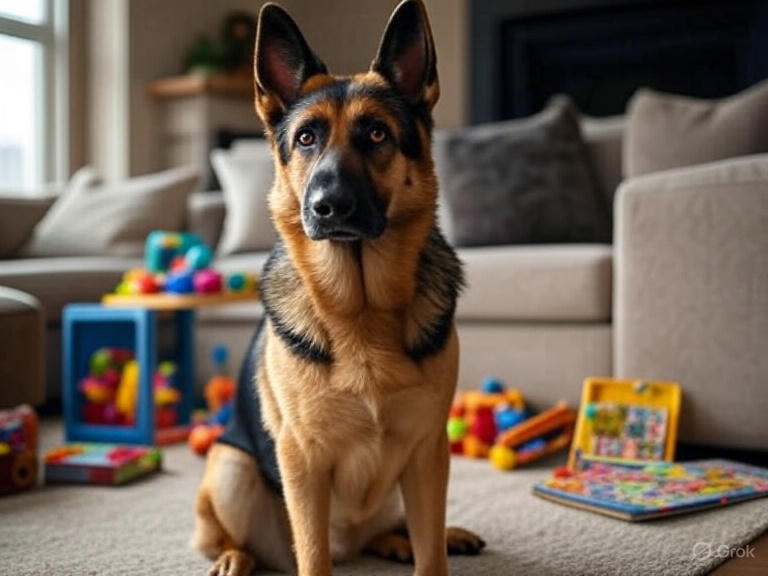German Shepherds are among the most intelligent and versatile dog breeds in the world, ranking consistently in the top 5 most popular breeds according to the American Kennel Club. Originally developed in 1899 by Captain Max von Stephanitz in Germany, these remarkable dogs were bred for their intelligence, loyalty, and working ability. However, their exceptional mental capacity comes with significant responsibility for owners who must provide adequate mental stimulation to prevent behavioral issues.
Understanding the German Shepherd’s Exceptional Intelligence
German Shepherds possess what canine behaviorists classify as “working intelligence” – the ability to learn commands quickly and retain complex training. According to Stanley Coren’s research published in “The Intelligence of Dogs,” German Shepherds rank third in working and obedience intelligence, capable of learning new commands in fewer than five repetitions and obeying first commands 95% of the time.
This intelligence level, while admirable, creates unique challenges for pet owners. Without proper mental engagement, German Shepherds can develop destructive behaviors, anxiety, and depression. The breed’s natural herding instincts and protection drive require channeling through appropriate activities to ensure a well-balanced companion.
Essential Mental Stimulation Activities for German Shepherds
Interactive Puzzle Games and Brain Teasers
Mental stimulation begins with challenging your German Shepherd’s problem-solving abilities. Interactive puzzle toys serve as excellent tools for engaging their cognitive functions while providing entertainment.
Level 1 Puzzles: Start with basic treat-dispensing toys that require simple manipulation. Kong Classic toys stuffed with frozen treats or peanut butter provide 20-30 minutes of focused activity. Puzzle feeders that require sliding or rotating pieces help slow down eating while stimulating problem-solving skills.
Level 2 Challenges: Advance to multi-step puzzle toys that require sequential actions. Nina Ottosson puzzle toys offer various difficulty levels, from beginner to expert. These toys typically feature sliding compartments, rotating discs, and hidden treat chambers that challenge your dog’s spatial reasoning.
Level 3 Advanced Activities: Create custom challenges using household items. Hide treats in empty toilet paper rolls, create snuffle mats using rubber sink mats and fleece strips, or design treasure hunts throughout your home. These activities engage your German Shepherd’s natural scavenging instincts while providing mental exercise.
Scent Work and Tracking Exercises
German Shepherds possess exceptional scenting abilities, with approximately 225 million olfactory receptors compared to humans’ 6 million. Harnessing this natural talent provides incredible mental stimulation opportunities.
Indoor Scent Games: Begin with simple “find it” games using high-value treats. Start by showing your dog the treat, then hiding it in an easy location while they watch. Gradually increase difficulty by hiding treats in multiple rooms or using scent articles.
Outdoor Tracking: Create tracking trails in your yard using treats or favorite toys. Start with straight lines and progress to turns and obstacles. This activity mimics their working heritage and provides both mental and physical exercise.
Professional Scent Work: Consider enrolling in organized scent work classes. These structured programs teach dogs to identify specific scents like birch, anise, and clove, providing advanced mental challenges and social opportunities.
Obedience Training Beyond Basic Commands
While German Shepherds master basic commands quickly, advanced training provides ongoing mental stimulation and strengthens the human-canine bond.
Trick Training: Teach complex tricks like “play dead,” “spin,” “weave through legs,” or “bring specific items by name.” These activities challenge memory, coordination, and problem-solving abilities.
Service-Style Tasks: Train practical behaviors like closing doors, turning light switches on/off, or bringing specific items. These tasks provide mental engagement while creating helpful household assistance.
Agility Training: Set up basic agility courses using household items or purchase professional equipment. Agility training combines physical exercise with mental challenges as dogs must remember sequences and respond to directional cues.
German Shepherd Behavior Around Children: Building Safe Family Relationships

German Shepherds can become excellent family companions when properly socialized and trained. However, their size, strength, and protective instincts require careful management around children to ensure safety for all family members.
Understanding German Shepherd Protective Instincts
German Shepherds were bred to be guardian dogs, making them naturally protective of their family unit. This trait, while valuable for home security, can become problematic if not properly channeled. According to research published in Applied Animal Behaviour Science, German Shepherds show higher territoriality and protective behaviors compared to many other breeds.
Resource Guarding: German Shepherds may exhibit protective behaviors around food, toys, or family members. Early training and socialization help prevent these behaviors from becoming problematic.
Stranger Wariness: The breed naturally exhibits caution around unfamiliar people, especially near their territory or family. This trait requires careful socialization to prevent excessive fearfulness or aggression.
Age-Appropriate Interaction Guidelines
Infants and Toddlers (0-3 years): Never leave German Shepherds unsupervised with very young children. Even well-trained dogs can accidentally knock down small children during play. Create positive associations by allowing the dog to observe children from a distance while receiving treats and praise.
Preschoolers (3-5 years): Teach children basic dog safety rules: no pulling ears or tails, no bothering the dog while eating, and always ask permission before petting. Supervise all interactions and use baby gates to create safe spaces for both children and dogs when needed.
School-Age Children (6-12 years): Involve children in basic training activities like teaching “sit,” “stay,” and “come.” This builds mutual respect and establishes the child’s position in the family hierarchy. Children should learn to recognize stress signals in dogs and respond appropriately.
Teenagers (13+ years): Older children can take more responsibility for dog care, including feeding, grooming, and advanced training. This deepens the bond while teaching responsibility and empathy.
Training Techniques for Family Integration
Positive Introduction Methods: When introducing German Shepherds to families with children, use gradual exposure techniques. Allow the dog to observe children from a comfortable distance while providing high-value treats and praise. Gradually decrease distance over multiple sessions as the dog shows calm, positive responses.
Boundary Training: Establish clear household rules and boundaries. German Shepherds should learn that children’s bedrooms, play areas, and mealtimes have specific rules. Use positive reinforcement to reward appropriate behavior and redirect unwanted behaviors.
Impulse Control Exercises: Practice “wait” and “leave it” commands regularly. These skills prove invaluable when children drop food, play with toys, or engage in activities that might excite the dog inappropriately.
Advanced Mental Stimulation Strategies
Rotating Activity Schedules
Prevent boredom and maintain engagement by rotating mental stimulation activities weekly. Create a structured schedule that includes different types of challenges:
Monday: Puzzle toys and food-dispensing activities Tuesday: Scent work and tracking exercises
Wednesday: Advanced obedience training Thursday: Interactive play and trick training Friday: Agility or obstacle courses Saturday: Social activities and new environment exploration Sunday: Rest day with gentle mental activities
Environmental Enrichment
Transform your living space into a mentally stimulating environment for your German Shepherd.
Vertical Spaces: Provide elevated resting areas and climbing opportunities. German Shepherds enjoy surveying their territory from higher vantage points.
Sensory Experiences: Introduce new textures, sounds, and smells regularly. Rotate toys weekly, play different types of music, and provide various surface textures for exploration.
Social Enrichment: Arrange regular interactions with other well-socialized dogs and people. German Shepherds thrive on social connections but require proper introduction protocols.
Health Benefits of Mental Stimulation
According to veterinary behaviorists, adequate mental stimulation provides numerous health benefits for German Shepherds:
Stress Reduction: Mental challenges release endorphins and reduce cortisol levels, promoting overall well-being and reducing anxiety-related behaviors.
Cognitive Preservation: Regular mental exercise may help prevent cognitive decline in senior dogs, similar to how mental activities benefit aging humans.
Physical Health: Many mental stimulation activities involve physical movement, supporting joint health and maintaining appropriate body weight.
Behavioral Improvement: Mentally satisfied dogs exhibit fewer destructive behaviors, excessive barking, and attention-seeking activities.
Common Mistakes to Avoid
Over-Stimulation Signs
While mental stimulation is crucial, over-stimulation can create stress and behavioral problems. Watch for these warning signs:
- Excessive panting after mental activities
- Inability to settle or relax after exercise
- Increased reactivity to environmental stimuli
- Difficulty sleeping or restlessness
- Loss of appetite or decreased interest in activities
Inappropriate Challenge Levels
Providing activities that are too easy leads to boredom, while overly difficult tasks create frustration and learned helplessness. Adjust challenge levels based on your dog’s individual capabilities and gradually increase difficulty as skills improve.
Inconsistent Training Approaches
German Shepherds thrive on consistency and clear expectations. Mixed messages from family members or inconsistent rules create confusion and anxiety. Establish household training protocols and ensure all family members follow the same guidelines.
Special Considerations for Different Life Stages
Puppies (8 weeks – 6 months)
German Shepherd puppies require gentle mental stimulation that supports brain development without overwhelming their young minds. Focus on:
- Short training sessions (5-10 minutes)
- Simple puzzle toys appropriate for teething
- Basic socialization experiences
- Positive associations with handling and grooming
Adolescents (6 months – 2 years)
Teenage German Shepherds often exhibit increased energy and testing behaviors. Mental stimulation during this period should include:
- Structured training sessions with clear boundaries
- Challenging puzzle toys and scent work
- Regular social interactions with other dogs
- Consistent exercise routines
Adults (2-7 years)
Mature German Shepherds can handle complex mental challenges and benefit from:
- Advanced training activities and job-like tasks
- Varied exercise routines and new experiences
- Leadership roles in family activities
- Regular mental challenges to prevent boredom
Seniors (7+ years)
Older German Shepherds may have physical limitations but still require mental stimulation. Adapt activities by:
- Reducing physical demands while maintaining mental challenges
- Using elevated food puzzles to accommodate joint issues
- Providing comfortable resting areas during activities
- Monitoring for signs of cognitive decline
Professional Resources and Support
When implementing mental stimulation programs for German Shepherds, professional guidance can prove invaluable. Certified dog trainers, veterinary behaviorists, and canine enrichment specialists provide expertise tailored to individual dogs and family situations.
Many pet owners find success using modern technology tools to enhance their training programs. Platforms like Snapspeak.pocketpets.site offer innovative approaches to understanding and communicating with pets, providing valuable insights into canine behavior and training strategies.
Building Long-Term Success
Creating a successful mental stimulation program for German Shepherds requires commitment, consistency, and adaptation over time. Regular assessment of your dog’s needs, adjustment of activities based on age and health status, and ongoing education about canine behavior contribute to long-term success.
Remember that mental stimulation needs vary significantly between individual dogs, even within the same breed. Some German Shepherds may prefer scent work over puzzle toys, while others excel at agility training. Pay attention to your dog’s preferences and natural abilities when designing their enrichment program.
The investment in proper mental stimulation pays dividends in the form of a well-adjusted, happy companion who can safely and successfully integrate into family life. As highlighted in previous discussions about pet neglect and proper care, providing adequate mental enrichment is not optional but essential for responsible pet ownership.
Conclusion
German Shepherds represent one of the most intelligent and capable dog breeds, but their exceptional abilities come with significant responsibility for their human families. Proper mental stimulation through varied activities, safe family integration protocols, and consistent training approaches create the foundation for successful relationships between German Shepherds and their families.
By implementing the strategies outlined in this guide, pet owners can ensure their German Shepherds receive the mental challenges they require while building safe, positive relationships with all family members, especially children. The key lies in understanding the breed’s unique characteristics, respecting their intelligence and capabilities, and providing structured opportunities for growth and enrichment throughout their lives.
Success with German Shepherds requires patience, consistency, and dedication, but the reward is an incredibly loyal, intelligent, and capable companion who enriches family life in countless ways. Whether serving as protectors, companions, or working partners, properly stimulated and well-socialized German Shepherds represent the pinnacle of human-canine relationships.

